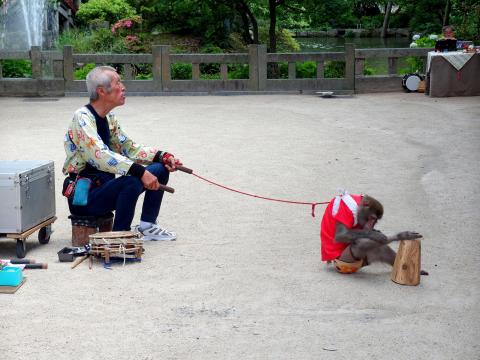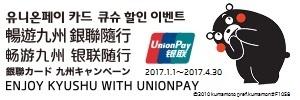ARTICLE
Funtastic Fukuoka
25/12/2015
- Author : See
- Country of Origin : Sweden
- Age : 30's
- Gender :male

Fukuoka is a wonderful introduction to Kyushu. It has the traditional and the modern and definitely something for everyone.
It was Sunday when I reached Fukuoka and that meant a trip to the Dazaifu Temangu Shrine. The main road leading to the shrine was abuzz with activity. The friendly shopkeepers called out to potential customers, school children thronged the street and tourists like me soaked up the festive atmosphere. There was no lack of things to try and buy and before I knew it, I caught a sweet scent of a delicious treat that I just couldn't resist.

Freshly grilled, this is the traditional Umegaemochi that is sold everywhere on the main street. It's aroma filled the air and I had to get one. Biting through the slightly crunchy rice cake, the taste of red bean paste fills the mouth. Careful! It might still be hot!

When I arrived at the Dazaifu Temangu Shrine, there were already a lot of devotees and tourists alike. This shrine is one of the most important Temangu Shrines in Japan. As Temangu shrines are dedicated to the spirit of Sugawara Michizane, a man of great learning, many students come to pay their respect and pray for good results.
Another interesting information has to do with the plum tree on the right. According to legend, this plum tree flew from Kyoto to Dazaifu when Michizane was exiled. Hence it is called the flying plum tree or the legendary tobiume. Now where else can you claim to have seen a flying plum tree?

Weekends are the best time to visit the shrine because there's always something going on. Just outside the shrine, this performer was entertaining the crowd with his pet monkey. The crowd was kept in stitches when the monkey ignored his master and did his own thing. Do remember to reward them for their effort.

I was lucky enough to catch a wedding procession where the bride and groom were in their traditional Japanese wedding attire. With graceful small steps, the bride moved with elegance and was the centre of attention indeed. Nonetheless, the groom was handsome in his garb and beaming with joy at his good fortune. On-lookers kept a respectful distance and wished them well.

Nearby, one of the must-visits is the Kyushu Museum. It is one of only 4 national museums and hosts a rich collection of items from Kyushu's history. Given that Kyushu was where trade with the outside world was allowed in the past, the influence and traces of China and the West could be seen in the architecture left behind in Kyushu. History buffs can rejoice and spend hours in here!

Along with the traditional is the modern and there is none more modern than Canal City Hakata. It has shops, restaurants, hotels, cinemas built on a, you guessed it, canal! Even if you have seen enough of shopping complexes, Canal City Hakata is still worth a look with its curving sculptures and dancing water fountain. I shopped to my heart's content here!

While shopping in Canal City Hakata, I spied the famous Ichiran Ramen! In Kyushu, there are many ramen stalls but Ichiran Ramen's history goes all the way back to the 60's and I was dying for a bowl. The process of ordering was so simple. Fill in an order form, pay, get a seat and wait for the steaming bowl to magically appear in front of you. They are kind enough to have instructions in English for non-Japanese speaking tourists like me. I slurped the bowl dry and I wasn't the only one!

When in Japan, one thinks of sushi and there's nothing fresher than sushi from the market. In Fukuoka, this means going to the Yanagibashi Market where fresh seafood abound. Get there early to catch the action as the locals go about doing their morning shopping. At some stalls, you can pick out the seafood you like and have them prepared for you on the spot. Sushi doesn't get any fresher than this!

Sometimes, wandering about the city reaps unexpected benefits. In this case, I was lucky enough to catch the end of a ceremony at the Sumiyoshi Shrine. These ladies were performing a ritual that I assume has to do with the planting of rice. It is heartening to see that young ladies like them are keeping the traditions alive and not afraid to get their feet dirty.

If the sight of the many traditional costumes has piqued your interest in wearing one, then head on down to Kawabatadori Shopping Street. Here, there're lots to see and it's perfect for shopping for yourself or getting some souvenirs for friends and family back home. How about trying on a kimono? I bought a few postcards from here.

And when you're done shopping, you can hop over to the Fukuoka Asian Art Museum. Expand your mind with the creations of Asian artists and be blown away by the variety. There are paintings, sculptures and installations waiting for you to explore. I was pleasantly surprised by the inclusion of Singaporean artists when I visited it.

So where can one get an aerial view of the city? Fukuoka Tower boasts the best view of the city from above and the hordes of tourists buses will attest to that! Not to worry, the queues are fast and after payment, I was escorted by the pretty attendants to the lift and soon sped up to the top through the intricate metal beams that I could see through the glass doors. The view? Magnificent!

However, if you have more time, like I did, or are a little tight on the budget, you can head towards the Maizuru Park and take a slow climb up the the castle remnants to reach this place for an aerial view of the city for free. The remains of a castle and the excavation site nearby will be of interest to history buffs.

Back in the city, at the Hakata Machiya Folk Museum, it showcases the traditional crafts of Fukuoka. Fukuoka is famous for a few things like scissors and textile. The weaving is intricate and anyone worth his salt can recognize a particular pattern on a piece of cloth as originating from Fukuoka. I bought a Japanese doorway cloth curtain for a friend from here.

Nearby the museum is the very important Kushida Shrine. Dating back to 757, the Hakata Gion Yamakasa festival is dedicated to this shrine. The festival is a grand affair with wondrous floats created and raced against each other, with the Kushida Shrine as it focal point.

Different neighbourhoods build their own floats with one fancier than the other. Each can weigh up to a tonne and one can only imagine the strength, coordination and tenacity needed to manoeuvre the giant construct much less race it against another. This proud tradition never fails to attract millions of spectators cheering them on. I managed to see a finished float, waiting for the race to be held 1-15 July annually.

If one isn't fortunate enough to catch the race, there's always the Fukuoka City Museum to see the history of the festival. It explains in detail how the event came about, the different parts of the float and significance of the idols on the float. I would appreciate an English translation but the pictures and dioramas were interesting enough by themselves. Of course, there are many other items of interest regarding the Japanese way of life such as the items needed for a Japanese wedding.

When night falls and hunger calls, why not try one of the roadside stalls? Commonly known as yatai, it's a cosy affair sitting almost cheek by jowl and watching the chef preparing food right in front of you. There's a wide selection of food, depending on which yatai you go to. There's ramen, yakitori and oden so every night is a new adventure!





![Kyushu Tourism Information [ Japan ]](/blogcontest/img/common/bnr_onsen_island.png)

